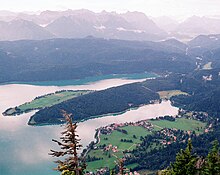Dwarfs
Zwergern is a peninsula on the western shore of the Walchensee . The name variant Katzenkopf is only used today for the ridge that runs through the peninsula. Zwergern is also the name of the wasteland of the Kochel am See community on the peninsula .
geography
The approximately two kilometer long peninsula belongs to the municipality of Kochel am See, is traversed by a ridge called Katzenkopf and has an area of around 1.4 square kilometers. It separates the Walchenseer Bay in the northwest from the Obernacher Winkel (also called the Bay of Zwergern , Zwerger Bucht or Einsiedler Winkel ) in the southwest. At its tip, the peninsula is again divided into two shorter peninsulas by the 300 meter long Zwergerner Bay : Klösterl peninsula in the west (named after the Klösterl Walchensee ) and St. Margareth peninsula in the east (named after the St. Margareth branch church ) . The St. Margaret Peninsula translates to about two kilometers away under water in Zwergerner back direction Kirchel reason , the Schweb of Walchensee to 47 ° 36 '3 " N , 11 ° 20' 47" O . The Klösterl peninsula, with the chapel corner as the point that is furthest forward into the lake, also continues under water, but only around 800 meters in the direction of the steep west bank. In between, as an extension of the Zwergerner Bucht, lies the Zwergerner Tal , which extends to the Kirchel Grund .
The hamlet of the same name Zwergern with the farms on the Zwergerner Bucht had 15 inhabitants in four buildings with living space or six apartments at the time of the census on May 25, 1987. The place also includes the somewhat remote Klösterl Walchensee, as well as the subsidiary church of St. Margareth . The place belongs to the parish Walchensee ( Ortisei ).
history
A stone ax from the Neolithic Age was found in the peninsula's Zwergerner Bay in 1962 and is exhibited in the Bad Tölz City Museum.
The settlement of the Zwergern peninsula began around 1160, when Schlehdorf Monastery had the dwarfs settle there, which then led to the clearing of the name.
In 1344 the dwarfs built the St. Margareth chapel .
In the 15th century, extensive ponds, harbors and reservoirs for fish farming were built in the Zwergerner Bucht, which came to light after the Walchensee power plant went into operation in the winter of 1924/25 when the lake subsided. These pile dwellings were measured by dwarfs in 2007 and 2008 by Jost Knaus and Martin Boehm, examined dendrochronologically and extensively documented.
The Klösterl auf Zwergern was founded in 1689 so that Father Onuphrius (a native of Tölzer) should pray in solitude for a male successor to Elector Maximilian II. Emanuel of Bavaria and his wife Maria Antonia of Austria , which was already fulfilled after four years and led to a lively pilgrimage to dwarfs.
Presumably all bearers of the family name Zwerger come from the Zwergern peninsula
In 1532 the brothers Duke Wilhelm and Duke Ludwig von Bayern awarded the four brothers Hans, Konrad, Jörg and Martin the dwarfs, who sat at Walchensee, with a coat of arms with all rights and due to their honesty, honesty and the many services they had rendered them To honor. The coat of arms shows a striding blue clad man (dwarf) with a pebble in his raised right hand. This honor for the dwarfs at Walchensee came about because the two happy Wittelsbachers and their large hunting party took quarters in the dwarfs' taverns and courtyards for years . The dwarfs also developed fish farming in the Walchensee and, because of their skills, were z. B. to the Heiterwanger See (near Reutte in Tyrol) and to the Reschensee (in South Tyrol) as a monastery fisherman.
The development of the Mittenwald dwarf line is interesting. Here, too, they first settled as fishermen, but they also had extraordinary skills as sculptors and violin makers. Dwarf violins are among the most valuable violins in this traditional place.
Soil monuments
Individual evidence
- ↑ E. Becker: The Walchensee and the Jachenau. Erfurt 1897 ( Memento from August 8, 2014 in the Internet Archive ), p. 4
- ↑ Zwergern in the local database of the Bavarian State Library Online . Bavarian State Library, accessed on December 29, 2017.
- ↑ E. Becker: The Walchensee and the Jachenau. Erfurt 1897 ( Memento of August 8, 2014 in the Internet Archive ), p. 4 and p. 121.
- ↑ Cornelia Oelwein: The history of the Walchensee and its fishing . Ed .: Martin Boehm. Uffing am Staffelsee 2010, ISBN 978-3-9813813-0-6 .
- ↑ Edwin Fels: New plumbing of the Walchensee. Journal of the Society for Geography in Berlin, 1922, pp. 145-147 (Small communications) , p. 146
- ↑ Edwin Fels: Tiefenkarte des Walchensee (1928) ( Memento of the original from February 12, 2015 in the Internet Archive ) Info: The archive link was inserted automatically and has not yet been checked. Please check the original and archive link according to the instructions and then remove this notice.
- ^ Official register of places for Bavaria, territorial status: May 25, 1987, Munich, 1991, page 68
- ↑ Oelwein, Cornelia, The history of the Walchensee and its fishing, [ed. Martin Boehm], Uffing am Staffelsee 2010, ISBN 978-3-9813813-0-6
Web links
Coordinates: 47 ° 35 ′ 0 ″ N , 11 ° 19 ′ 10 ″ E
